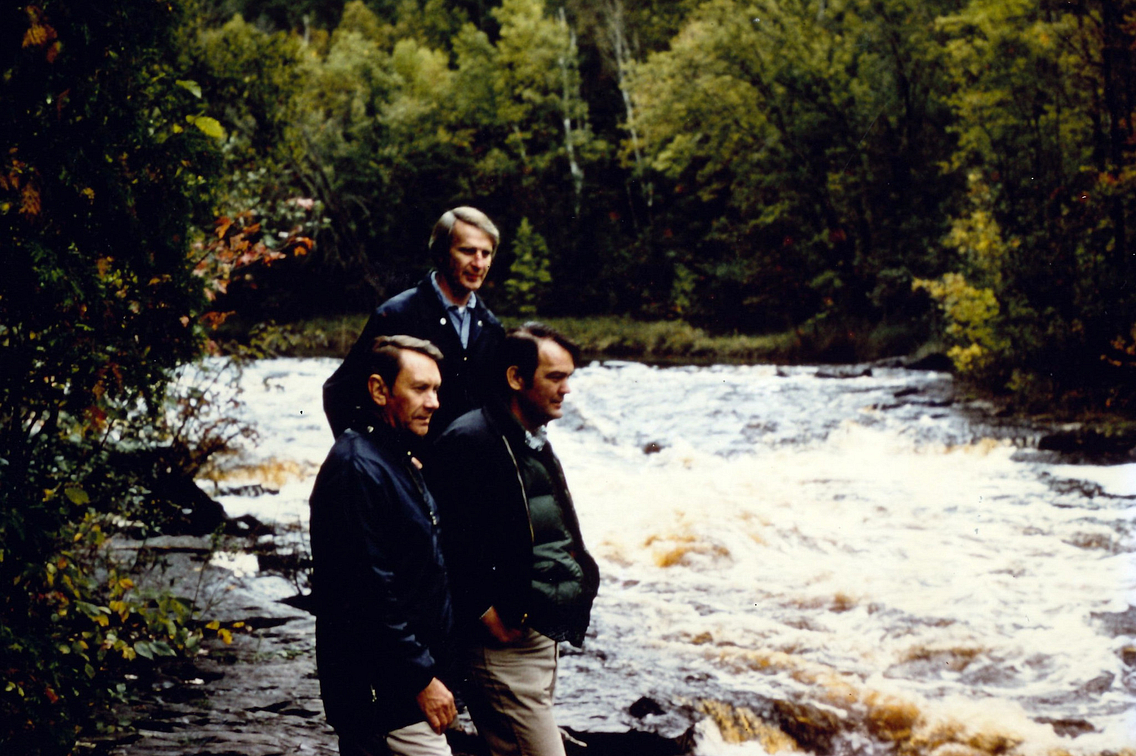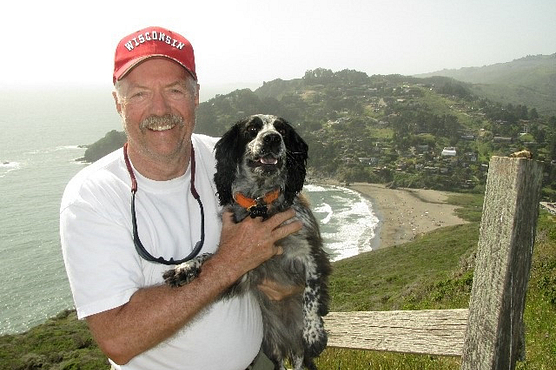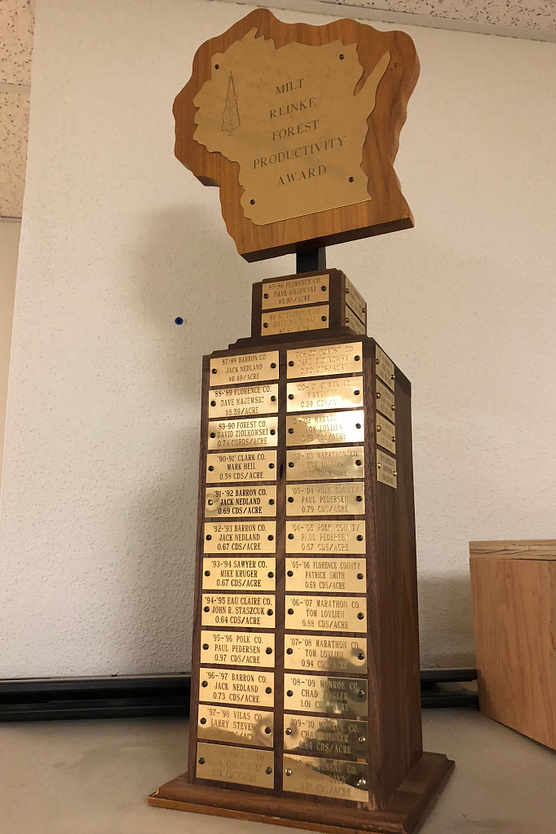DNR memoirs
A DOZEN FORMER STAFFERS — WITH A COMBINED TENURE OF MORE THAN 380 YEARS — RECOUNT THEIR DEDICATION TO WISCONSIN'S NATURAL RESOURCES.
As our magazine continues its celebration of the DNR's 50th year, what's been missing are personal accounts from former and retired longtime employees who contributed to the agency's past. These career public servants are the people behind the DNR who wrote the rules, tested the waters, fought the fires, framed the partnerships and planted the ideas of change. We recently asked DNR retirees to send us their recollections of key events or programs most memorable to them. Here are some of their submissions.
Compiled by Kathryn A. Kahler
Protecting wild waterways
Charlie Higgs
 Then-DNR secretary Tony Earl (in back), Resource Division Administrator Buzz Besadny (left) and Lake Michigan District Director Charlie Higgs viewed LaSalle Falls on the Pine River in 1980.
Then-DNR secretary Tony Earl (in back), Resource Division Administrator Buzz Besadny (left) and Lake Michigan District Director Charlie Higgs viewed LaSalle Falls on the Pine River in 1980.© DICK FAUCETT
The Flambeau, Brule, Oconto, Wolf, Fox, Peshtigo, Manitowoc, Menominee, Namekagon, St. Croix, Chippewa and Wisconsin are the rivers where I spent a significant amount of work time during 36-plus years with DNR. In addition the Pike, Pine and Popple state-designated Wild Rivers commanded a lot of my time and energy.
In early fall of 1980, Marinette-area land agent Dick Faucett arranged a visit to assess progress on the Wild Rivers program. Then-DNR Secretary Tony Earl, Resource Division Administrator Buzz Besadny, Faucett and I made the 2- to 3-mile round trip along a foot path to the base of LaSalle Falls. This was and remains one of the most remote and wildest places in Wisconsin.
The rivers of Wisconsin played an important role in the settlement and development of the state. That role left many of the rivers polluted and degraded. Fortunately, with strong public and political support, especially from the 1960s forward, that situation has been greatly improved.
I feel great satisfaction to have been a part of the effort by the men and women of DNR representing so many disciplines. It took all of us to achieve this remarkable recovery! These waterways are treasures to be enjoyed and cherished by residents and visitors alike.
Charlie Higgs' DNR career spanned more than three decades (1962-98), mostly stationed in Green Bay. He currently resides in Fort Collins, Colorado.
Wolf plate success
Chuck Pils
When I became director of the Bureau of Endangered Resources (BER) in the early 1990s, I made it a personal priority to come up with a major funding source for BER, which operated primarily on donations to fund management of rare species and habitats. Some states used special license plate revenues. Why couldn't Wisconsin do the same?
I was lucky! I mentioned this possibility during a 1995 meeting with The Nature Conservancy, whose government relations staff person was future Madison mayor Dave Cieslewicz. He thought it was an excellent idea. He found a legislative sponsor for the proposal and a bill was passed into law that same year!
We formed a committee with the Department of Transportation to get their buy-in and later announced that DNR was holding a contest seeking images for a new BER license plate. Eventually, the prize winner came up with the timber wolf as the figure to be placed on the license plate.
The rest is history: The original plate was revised to feature a badger and now eagles. To date, the plate has raised nearly $10 million.
Chuck Pils retired in 1999 after 33 years of service with DNR's Bureaus of Research, Wildlife Management and Endangered Resources. He resides in Madison.
Gamekeeper turned historian
David Gjestson
 Dave Gjestson now lives in the southwestern U.S., where he hikes daily with his dog, Greta.
Dave Gjestson now lives in the southwestern U.S., where he hikes daily with his dog, Greta.© COURTESY OF DAVID GJESTSON
The history of the Wisconsin DNR is a fascinating story of science development and professionals dedicated to protecting the environment and the quality of life in the Badger State. Conservation wardens initiated the effort in the 1800s, long before they were followed by foresters, forest rangers, game managers, fish managers and park superintendents in the following century.
The reorganization of the Wisconsin Conservation Department and Resource Development into the Department of Natural Resources in 1967-68 expanded traditional resource management programs to include air, water and solid waste regulatory programs that were precedent-setting environmental programs in the United States. Endangered and threatened plant and animal laws created in 1972 coupled with natural heritage inventories and technological advancements in the 1980s rounded out the broad challenges facing resource managers today.
Wisconsin's proud history of accomplishment in conservation programs is captured in my book, "The Gamekeepers — Wisconsin Wildlife Conservation from WCD to CWD."
David L. Gjestson's 30- year DNR career began as a field biologist with the Bureau of Wildlife Management. His avocation and passion for DNR's history culminated with publication of his book, which is a primary resource for DNR history. Check your local library or visit The Gamekeepers for purchasing information. Gjestson currently resides in Rio Rico, Arizona.
Forging forestry partnerships
Harry Mills
 An award for county foresters is named in honor of Milt Reinke who in 1972 created the DNR county specialist position.
An award for county foresters is named in honor of Milt Reinke who in 1972 created the DNR county specialist position.© DNR FILES
In 1972, the county forest specialist position was created in the Bureau of Forestry, a job to which I was the first to be assigned.
The County Forest Program originated in the late 1920s. By 1972, there were 28 northern and central counties participating with 2.25 million acres enrolled under Chapter 28.11, Wis. Stats. It was designed as a partnership whereby the counties provided the land and an administrator to direct local management and the state provided technical and financial assistance. Each county had a local state department forester assigned as a liaison to work with the respective administrator and forestry committee.
In 1972, Milt Reinke, then director of the Bureau of Forestry, created the county specialist position to help streamline communications between the field and central office and help keep state-level efforts in tune with evolving county program needs. I was assigned and enjoyed this position until my retirement in 1989.
Working with the Wisconsin County Forest Association was very rewarding. This organization is comprised of a county board member from each participating county and an executive secretary. Being able to develop and forge a closer relationship between the state and the counties was a highlight of my employment as a forester with the DNR.
This county forest program continues to flourish today by providing forest products, abundant wildlife and recreational opportunities for Wisconsinites and tourists alike.
Harry Mills worked for DNR for more than 32 years. His forestry career began in 1957 with the Wisconsin Conservation Department in Tomahawk. He currently resides in Wausau.
Early DNR IT milestones
Linda Morgan Wills
Linda Wills was a longtime program assistant for the Bureau of Information Management in Madison. She submitted a 25-year IT timeline, some of which is excerpted here. Wills retired in 2015 and resides in Madison.
- Early 1980s — Placed computer terminals in the six district headquarters offices
- 1980 — First five desktop PCs purchased by the Environmental Quality Division, price tag about $5,000 each. The bureaus of Solid Waste Management, Air Quality Management and Information Management were the recipients.
- 1980 — PCs purchased for "computer rooms," where DNR staff reserved time to use. PCs eventually became truly personal, as prices dropped and capabilities improved.
- 1988 — DNR installed its own statewide network, followed by massive adoptions of desktop PCs.
- Early 1990s — DNR was the first Wisconsin state agency to access the Internet.
- 2000 — DNR passed into new millennium without failure of any IT systems.
- 2001 — DNR joined the State Portal, providing the public Internet access to online systems.
Travel on a tight budget
Ron Poff
My first assignment in spring 1960 was to sample fish on Kenosha County lakes. It was cold, dark, foggy and raining at the end of the first day. I had to find a motel in Wisconsin for the night and mistakenly stayed over the line in Illinois. I had a lot of explaining to do to justify out-of-state travel and a $4 room charge. Ah, the good old days. We could be reimbursed $.65 for breakfast, $.85 for lunch and $1.25 for dinner, as I recall.
Ron Poff retired in 1998 after 42 years in Fish Management, 12 at the Nevin Fish Hatchery. He lives in Madison.
Three generations of DNR
George, Sam and Marshall Ruegger
George Ruegger began working as a state trapper with the Wisconsin Conservation Department in the late 1930s, assisting small farmers in extremely rural northern Wisconsin where bears were damaging crops and killing livestock. A seasoned trapper, during his tenure George took over 100 bears, provided the first live-trapped timber wolves for the Poynette game farm and removed many beavers doing damage to town roads and fields. George also served as an advisor to deer studies that wildlife managers led in the 1940s.
George's son Sam came home from high school in Hillsboro in 1928 and upon getting off the train spotted a lookout tower for forest fires on the north hill outside of Radisson. The next day he went to Hayward to meet with Mr. LeMay, the district ranger, and started working as the Radisson tower lookout. The next spring, he went to Hayward as a junior ranger, and in 1939 supervised the Works Progress Administration building of the Winter Ranger Station where he served as the forest ranger until 1970.
 Not only did all three generations of Rueggers work for DNR, they contributed to the maintenance and preservation of Ojibwa Roadside Park in Sawyer County.
Not only did all three generations of Rueggers work for DNR, they contributed to the maintenance and preservation of Ojibwa Roadside Park in Sawyer County.© DNR FILES
Sam's son Marshall started in Mercer as a fire control dispatcher and moved several times as the Ladysmith ranger, Dodgeville-area ranger, southern district fire staff specialist and then to the central office as the fire equipment specialist, where he worked with fire departments across the state. His proudest assignment was as the 50-state forester's representative to the National Fire Equipment Committee. He was also a member of the first out-of-state fire crew.
All in all, three generations of the Ruegger family served the citizens of Wisconsin with more than 87 years of service. The Rueggers also served as emergency fire wardens after their retirements, for a combined total of 62 additional years.
Ojibwa Roadside Park (Town of Winter, Sawyer County) also benefited from their services. George was a seasonal caretaker, Sam was the park supervisor and Marshall was the town chairman and park supervisor after the DNR turned it over to the township in 1990.
Marshall Ruegger, who submitted this family history of DNR service, retired in 1993 after 30 years with WCD and DNR and lives in Mount Horeb.
Story behind phosphate ban
Duane Schuettpelz
Laundry detergents in the 1960s contained significant amounts of phosphates to produce clean clothes. Although phosphate content in the detergents had decreased into the 1970s, the concentrations of phosphorus in municipal wastewater was still of concern due to increasing algae and weeds in lakes and streams.
Following several other jurisdictions around the Great Lakes, the Wisconsin Legislature enacted a ban on the amount of phosphates allowed in laundry detergent, effective in mid-1979. This law contained a sunset date and expired three years later. Home economists, along with the washing machine and laundry detergent industries opposed the law, claiming that clothes washed in detergents without phosphates were not clean and that substitute detergents caused early breakdowns of washing machines.
In the three years the ban was in effect, the DNR was directed to investigate whether the ban had any effect on water quality in the state. The study found reductions in the amount of phosphorus in wastewater, but due to the short time allowed, was not able to discern any changes in water quality.
After the ban expired, hearings were held, pitting opponents of the ban against DNR and other advocates. Fortunately, the law banning phosphates in detergents was re-enacted and became effective in January 1984. There was no indication after this date that the problems claimed by the ban's opponents ever occurred, probably because substitute detergents (primarily liquids) performed as well or better than those containing phosphates.
Duane H. Schuettpelz was a DNR water quality engineer from 1967 until his retirement in 2008. He lives in Madison.
Answering the environmental challenge: Paul Didier and Carl Blabaum
Two longtime DNR bureau directors who were instrumental in the early water pollution permitting process both got their start in the Department of Resource Development, transitioning together in 1968 to the new Department of Natural Resources.
Paul Didier was a newly hired engineer with DRD who in December 1966 had received an announcement that the state was seeking applicants for "a substantial increase in personnel" to implement new laws to protect Wisconsin's waters.
"I was sitting at my desk in Milwaukee with five kids at home," Didier recalled. "The starting pay was $750 a month and I said to my wife, 'This is an opportunity we just can't pass up!'"
Aside from the salary, Didier was hooked by a paragraph in the announcement that read: "If you would like to be associated with this challenging, exciting program — one that will require imagination, initiative and dedication, if you want to be a part of a hard-working, top-notch team that is determined to set a pattern other states can follow, the Water Resources Division of the Wisconsin Department of Resource Development would like to hear from you."
He applied and was hired as a public health engineer in 1967.
Carl J. Blabaum, who died in 2016 at the age of 87, worked beside Didier for three decades. He directed DNR's Bureau of Wastewater Management and was part of the team effort to develop the water pollution permitting process in the early 1970s.
Didier described those early years of DNR's organizational history.
"We first had to deal with President Nixon's order to invoke the 1899 Refuse Act, requiring any person discharging to navigable waters of the U.S. to obtain a permit. The Federal Water Pollution Control Agency came to Wisconsin and started holding hearings, the first of which was at the Holiday Inn in Neenah-Menasha. The Industrial Waste Water Section, newly formed in August 1970, tried to help identify our 'major dischargers' — paper mills, power plants and so forth — and get those permits out there for discussion.
"That, however, never happened because of the objections raised by industries that such action under an antiquated federal law wasn't justified. A short time later Congress passed the Clean Water Act in October 1972, and we got our own laws up to speed with corresponding statutes in mid-1973.
"We then obtained full authorization to administer the National Pollutant Discharge Elimination System permit program in Wisconsin — the WPDES program — at a hearing at the Pfister Hotel in Milwaukee on Dec. 18, 1973. We were on our way!
"We had some 600 'major dischargers' and the goal was to get them all issued by Dec. 31, 1974, and we made that goal. Carl Blabaum won a bet with an influential official at EPA for a bottle of brandy when we accomplished it!"
Didier went on to become director of the Bureau of Solid and Hazardous Waste Management in 1982, retiring in 1998.
Reminiscing about his work with Blabaum, Didier said: "Carl was memorialized at a luncheon shortly after his death in 2016. Donations in his honor — which totaled over $1,500 — were used to buy several fishing boats and a plaque at the boat landing at the Blackhawk Lake Recreation Area near his home in Highland. The plaque reads, 'Supported in memory of Carl J. Blabaum, P.E., who devoted his life to clean water for Wisconsin.'"
— Kathryn A. Kahler

